
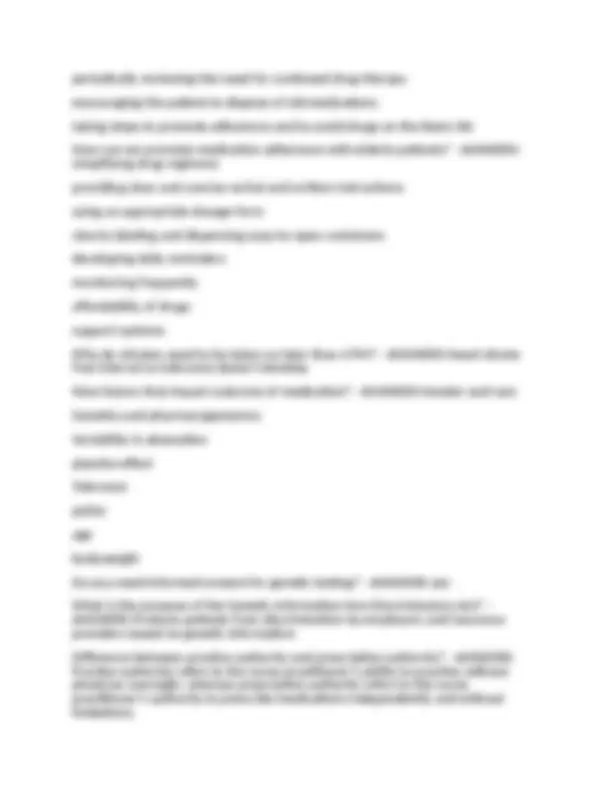
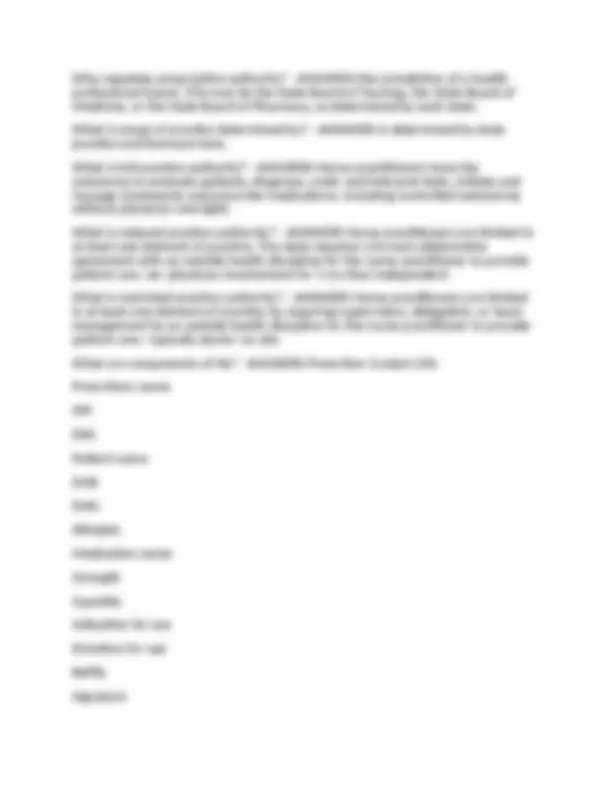
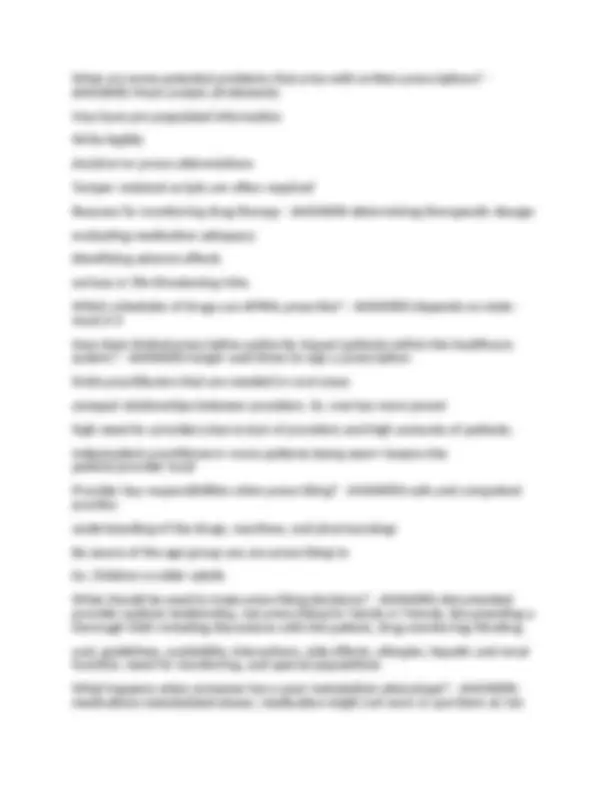
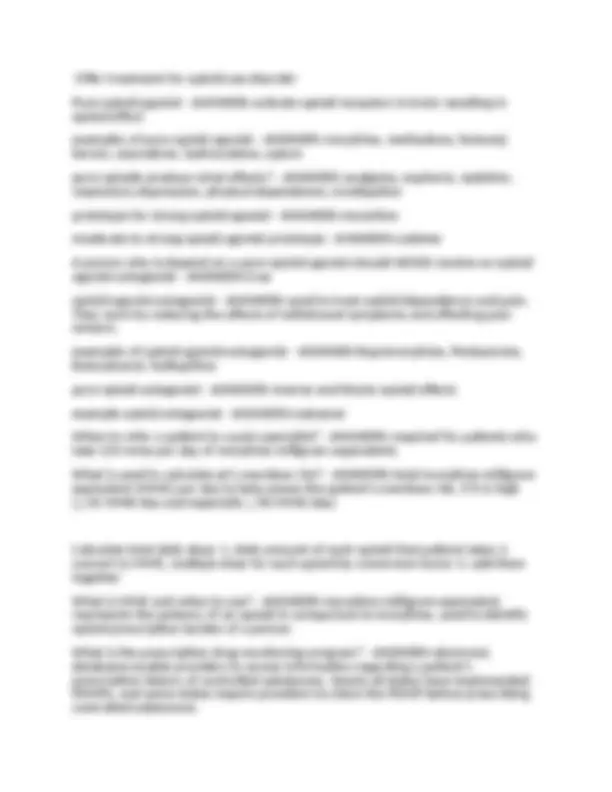
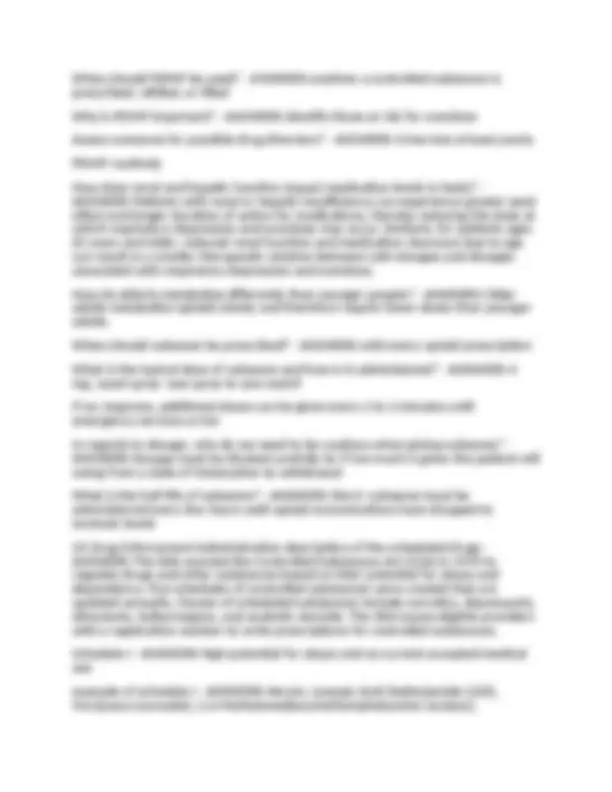
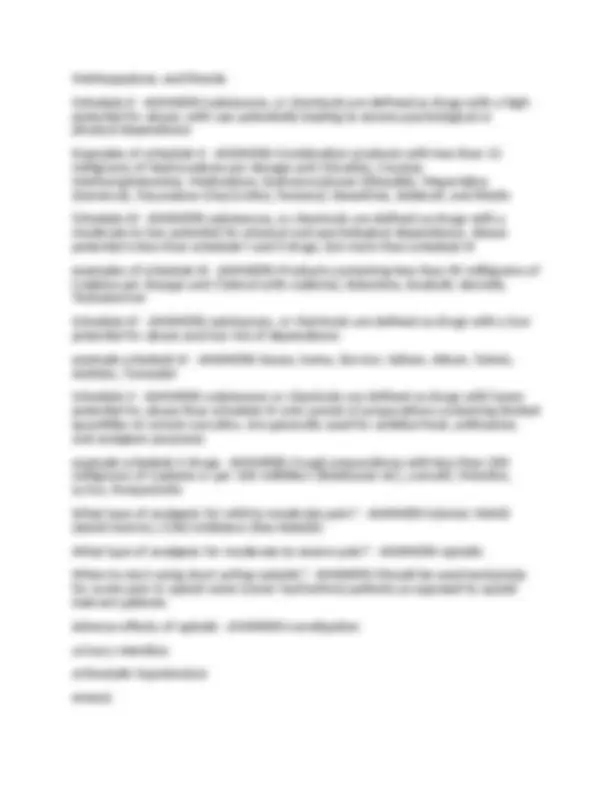
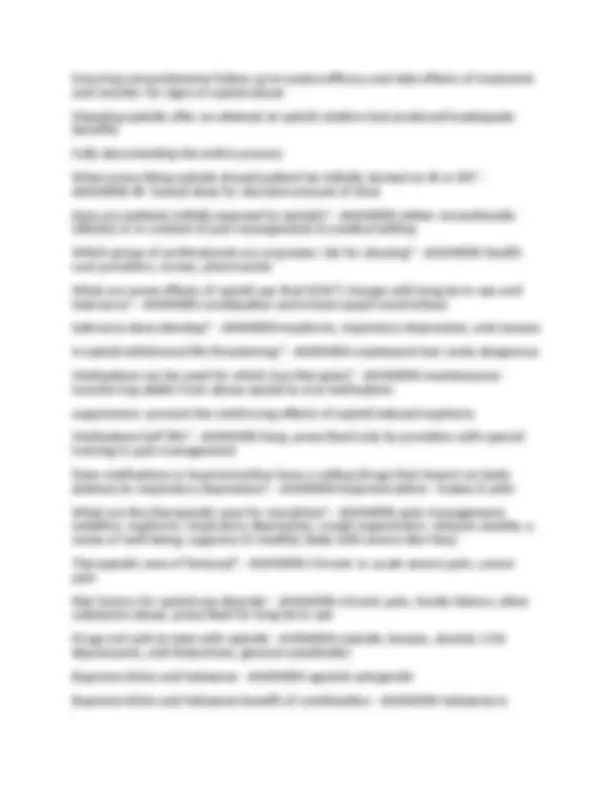
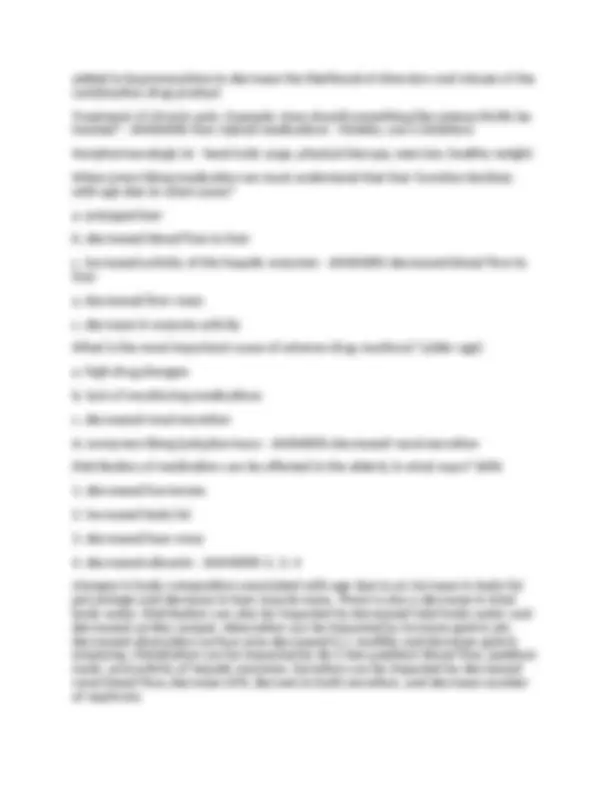
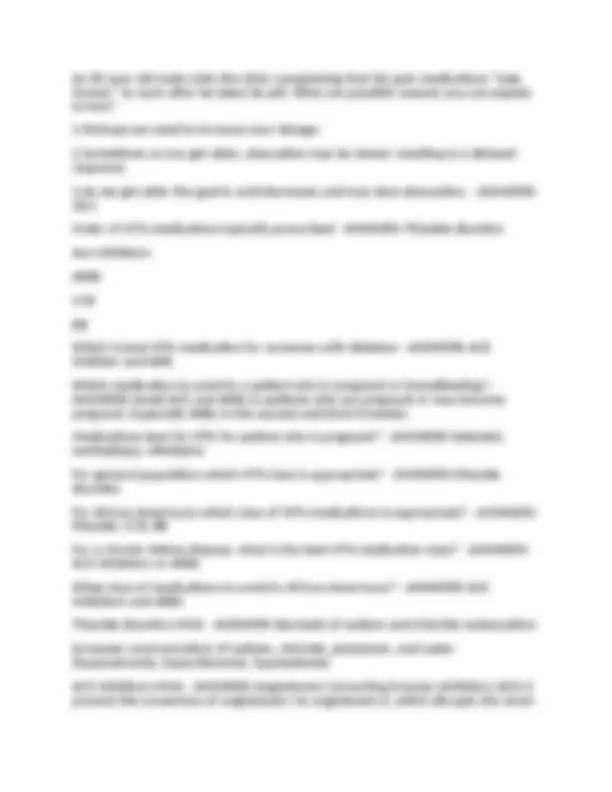
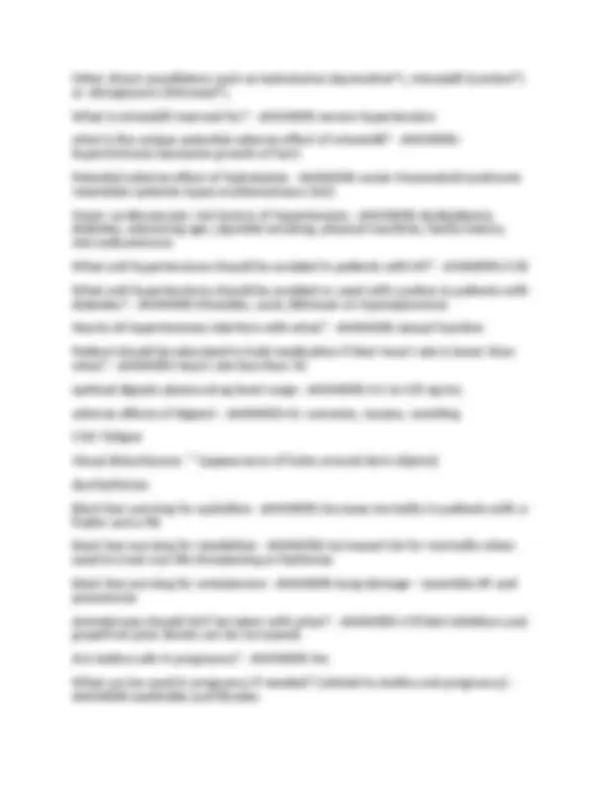
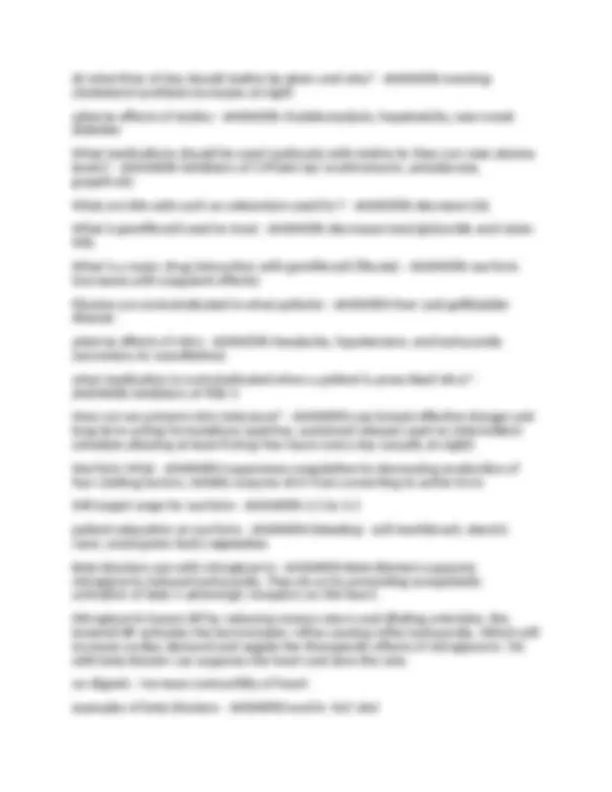
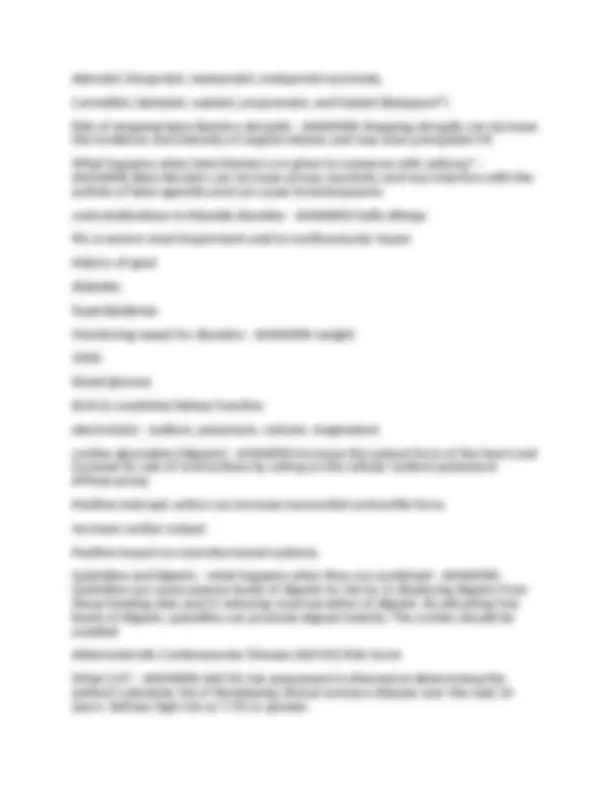
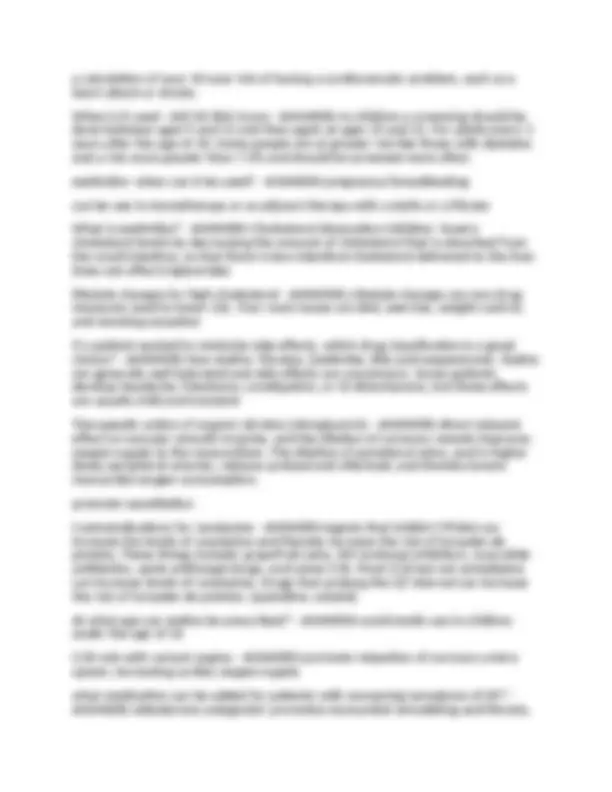
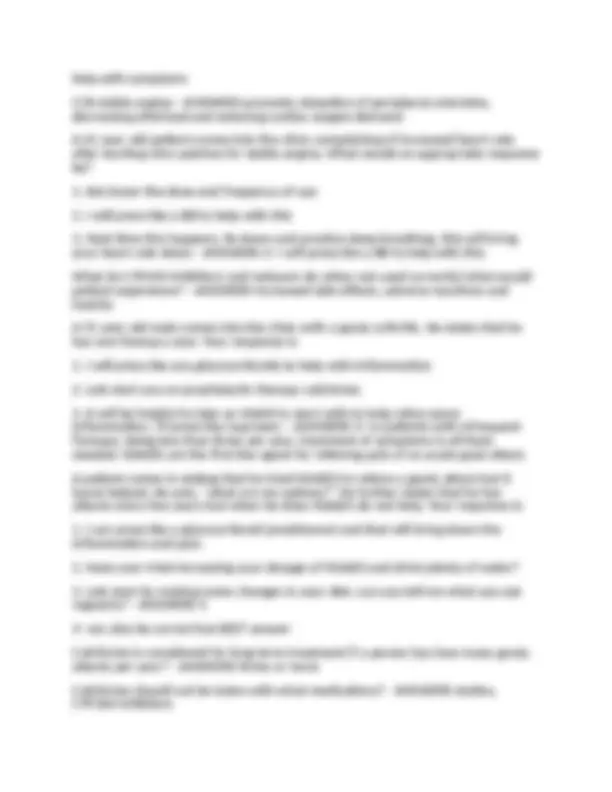
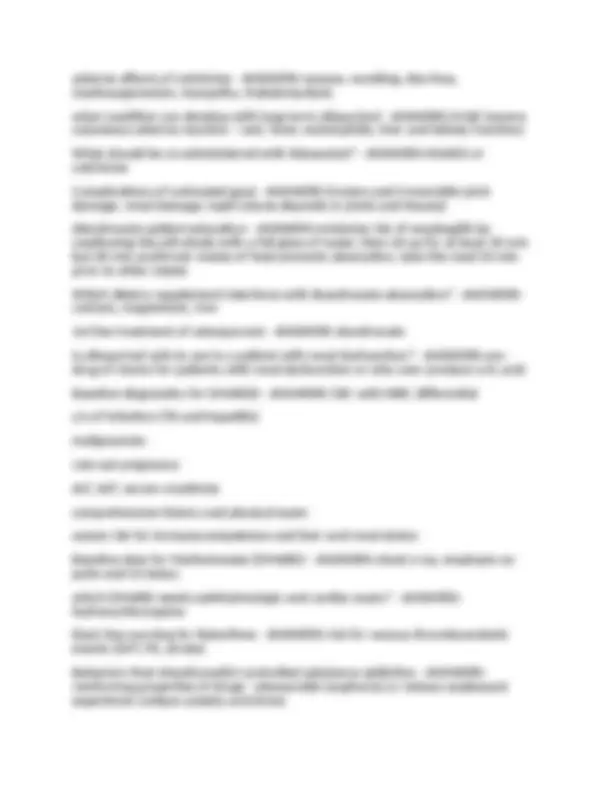
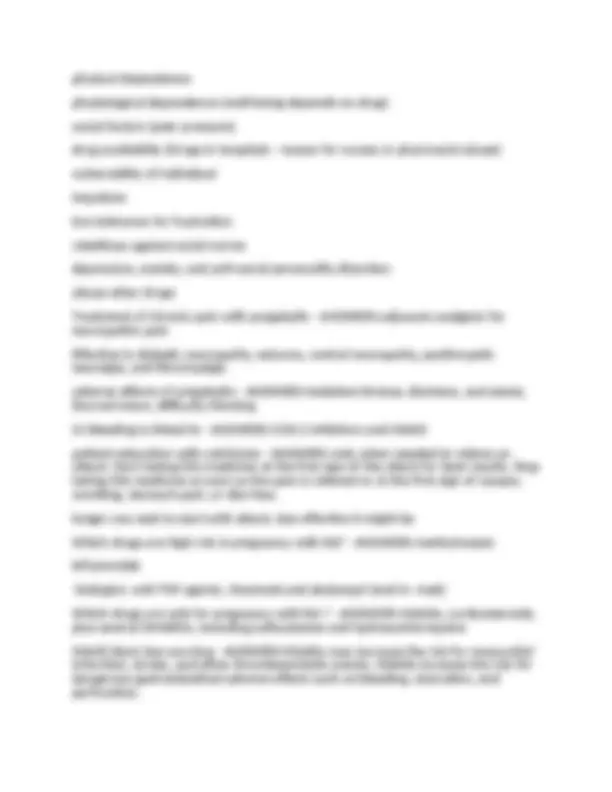
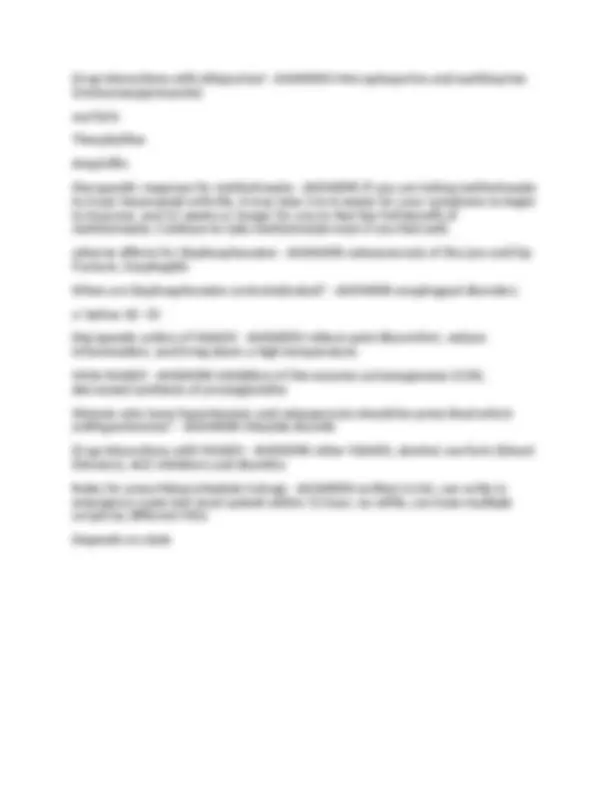


Study with the several resources on Docsity

Earn points by helping other students or get them with a premium plan


Prepare for your exams
Study with the several resources on Docsity

Earn points to download
Earn points by helping other students or get them with a premium plan
Community
Ask the community for help and clear up your study doubts
Discover the best universities in your country according to Docsity users
Free resources
Download our free guides on studying techniques, anxiety management strategies, and thesis advice from Docsity tutors
NR 565 - advanced pharmacology midterm - Chamberlain 2025 Latest Update Graded A+ Pass Complete Questions And Answers . NR 565 - advanced pharmacology midterm - Chamberlain 2025 Latest Update Graded A+ Pass Complete Questions And Answers .
Typology: Exams
1 / 25

This page cannot be seen from the preview
Don't miss anything!


















During what trimester is a pregnant woman most at risk for adverse drug reactions with potential long term consequences? - ANSWERS-1st trimester (fetus most at risk d/t rapid growth) What is BEERS criteria? - ANSWERS-Recommendations of medications inappropriate for elderly (65 and older), prescriber ultimately decides What is the CYP450 (cytochrome P450) - ANSWERS-liver enzyme system where medications are metabolized, can either be inducers or inhibitors and create drug- drug interactions CYP450 inducers - ANSWERS-Speed up metabolism of drugs (drug is cleared faster), drug has lesser effect (decrease blood levels of drug), elevate CYP enzymes CYP450 inducers pneumonic - ANSWERS-"Bullshit Crap GPS INDUCES rage" CYP450 inducer drug names - ANSWERS-Barbituates, St John wort, Carbamazepine, rifampin, alcohol, phenytoin, griseofulvin, phenobarbital, sulfonylureas CYP450 inhibitors - ANSWERS-inhibit metabolism, increase blood levels of medications CYP450 pneumonic - ANSWERS-"VISA credit card debt INHIBITS spending on designers like CK to look GQ" CYP450 inhibitors drug names - ANSWERS-Valproate, isoniazid, sulfonamides, amiodarone, chloramphenicol, ketoconazole, grapefruit juice, quinidine Physiological changes during pregnancy that impact pharmacodynamics and pharmacokinetic properties of drugs? - ANSWERS-increase glomerular filtration rate leads to increase durg excretion increase hepatic metabolism decrease tone and motility of bowel increase drug absorption Examples of medications that can be teratogenic - ANSWERS-Antiepileptic drugs, antimicrobials such as tetracyclines and fluoroquinolones, vitamin A in large doses, some anticoagulants, and hormonal medications such as diethylstilbestrol (DES). How is absorption of intramuscular medications different in neonates? - ANSWERS-slow and erratic due to low blood flow in muscles first few days of life
Why is absorption of medication in the stomach increased in infancy? - ANSWERS- delayed gastric emptying Some medications that should be avoided in the pediatric patient? - ANSWERS- glucocorticoids, discoloration of developing teeth with tetracyclines, and kernicterus with sulfonamides, levofloxacin (antibiotics) aspirin (Severe intoxication from acute overdose) what should be included in medication administration patient education? - ANSWERS-dosage size and timing route and technique of administration duration of treatment drug storage nature and time course of desired responses nature and time course of adverse responses finish taking antibiotic What are some things that put the elderly patient at higher risk for adverse drug reactions? - ANSWERS-reduced renal function polypharmacy (the use of five or more medications daily) greater severity of illness presence of comorbidities use of drugs that have a low therapeutic index (e.g., digoxin) increased individual variation secondary to altered pharmacokinetics inadequate supervision of long-term therapy poor patient adherence How can healthcare providers decrease likelihood of an elderly patient experiencing an adverse drug reaction? - ANSWERS-obtaining a thorough drug history that includes over-the-counter medications considering pharmacokinetic and pharmacodynamics changes due to age monitoring the patient's clinical response and plasma drug levels using the simplest regimen possible monitoring for drug-drug interactions and iatrogenic illness
Who regulates prescriptive authority? - ANSWERS-the jurisdiction of a health professional board. This may be the State Board of Nursing, the State Board of Medicine, or the State Board of Pharmacy, as determined by each state. What is scope of practice determined by? - ANSWERS-is determined by state practice and licensure laws. What is full practice authority? - ANSWERS-Nurse practitioners have the autonomy to evaluate patients, diagnose, order and interpret tests, initiate and manage treatments and prescribe medications, including controlled substances without physician oversight. What is reduced practice authority? - ANSWERS-Nurse practitioners are limited in at least one element of practice. The state requires a formal collaborative agreement with an outside health discipline for the nurse practitioner to provide patient care. ex/ physician involvement for 5 yrs than independent What is restricted practice authority? - ANSWERS-Nurse practitioners are limited in at least one element of practice by requiring supervision, delegation, or team management by an outside health discipline for the nurse practitioner to provide patient care.- typically doctor on site What are components of Rx? - ANSWERS-Prescriber Contact info Prescribers name NPI DEA Patient name DOB Date Allergies Medication name Strength Quantity Indication for use Direction for use Refills Signature
What are some potential problems that arise with written prescriptions? - ANSWERS-Must contain all elements May have pre-populated information Write legibly Avoid error prone abbreviations Tamper resistant scripts are often required Reasons for monitoring drug therapy - ANSWERS-determining therapeutic dosage evaluating medication adequacy identifying adverse effects serious or life-threatening risks. Which schedules of drugs can APRNs prescribe? - ANSWERS-depends on state - most II-V How does limited prescriptive authority impact patients within the healthcare system? - ANSWERS-longer wait times to sign a prescription limits practitioners that are needed in rural areas unequal relationships between providers. Ex. one has more power high need for providers due to lack of providers and high amounts of patients. Independent practitioners= more patients being seen= lessens the patient/provider load Provider key responsibilities when prescribing? - ANSWERS-safe and competent practice understanding of the drugs, reactions, and pharmacology Be aware of the age group you are prescribing to Ex. Children vs older adults What should be used to make prescribing decisions? - ANSWERS-documented provider-patient relationship, not prescribing for family or friends, documenting a thorough H&P, including discussions with the patient, drug monitoring/titrating. cost, guidelines, availability, interactions, side effects, allergies, hepatic and renal function, need for monitoring, and special populations What happens when someone has a poor metabolism phenotype? - ANSWERS- medications metabolized slower, medication might not work or put them at risk
heavy black border. Why are black box warnings issued? - ANSWERS-Issued by the FDA due to having serious or life-threatening risks What is neonate and infant drug dosing based on? - ANSWERS-weight or body surface area (BSA) After age one what happens to pharmacokinetic parameters, including drug sensitivity? - ANSWERS-mirror adult parameters Children under two have fast metabolism - ANSWERS-true How is absorption of transdermal medications different in neonates? - ANSWERS- more rapid and complete in infants than in older children and adults. the skin is very thin and blood flow is great in infants How is absorption of oral medications different in neonates? - ANSWERS- absorption may be enhanced or impeded depending on the properties of the drug. gastric emptying is irregular, drugs absrobed in the intestine are absorbed slower. Common fears with genetic testing - ANSWERS-Lack of education - many health care providers do not possess the knowledge or comfort to interpret the tesgin financial cost - many insurance plans do not cover this. cost can be from $100-
discrimination from employers, insurance companies or providers 12 CDC guidelines for prescribing opioids - ANSWERS-Opioids are not first line therapy establish goals for pain and function Discuss risks and benefits Use immediate release opioids when starting Use the lowest effective dose Prescribe short durations for acute pain Evaluate benefits and harms frequently Use strategies to migrate risk Review PDMP data Use urine drug testing Avoid concurrent opioid and benzo prescribing
Offer treatment for opioid use disorder Pure opioid agonist - ANSWERS-activate opioid receptors in brain resulting in opioid effect examples of pure opioid agonist - ANSWERS-morphine, methadone, fentanyl, heroin, oxycodone, hydrocodone, opium pure opioids produce what effects? - ANSWERS-analgesia, euphoria, sedation, respiratory depression, physical dependence, constipation prototype for strong opioid agonist - ANSWERS-morphine moderate to strong opioid agonist prototype - ANSWERS-codeine A person who is depend on a pure opioid agonist should NEVER receive an opioid agonist antagonist - ANSWERS-true opioid agonist-antagonist - ANSWERS-used to treat opioid dependence and pain. They work by reducing the affects of withdrawal symptoms and affecting pain sensors. examples of opioid agonist-antagonist - ANSWERS-Buprenorphine, Pentazocine, Butorphanol, Nalbuphine pure opioid antagonist - ANSWERS-reverse and blocks opioid effects example opioid antagonist - ANSWERS-naloxone When to refer a patient to a pain specialist? - ANSWERS-required for patients who take 120 mme per day of morphine milligram equivalents What is used to calculate pt's overdose risk? - ANSWERS-total morphine milligram equivalent (MME) per day to help assess the patient's overdose risk. If it is high (≥50 MME/day and especially ≥90 MME/day) Calculate total daily dose: 1. daily amount of each opioid that patient takes 2. convert to MME, multiply dose for each opioid by conversion factor 3. add them together What is MME and when to use? - ANSWERS-morphine milligram equivalent, represents the potency of an opioid in comparison to morphine, used to identify opioid prescription burden of a person What is the prescription drug monitoring program? - ANSWERS-electronic databases enable providers to access information regarding a patient's prescription history of controlled substances. Nearly all states have implemented PDMPs, and some states require providers to check the PDMP before prescribing controlled substances.
Methaqualone, and Peyote Schedule II - ANSWERS-substances, or chemicals are defined as drugs with a high potential for abuse, with use potentially leading to severe psychological or physical dependence Examples of schedule II - ANSWERS-Combination products with less than 15 milligrams of Hydrocodone per dosage unit (Vicodin), Cocaine, Methamphetamine, Methadone, Hydromorphone (Dilaudid), Meperidine (Demerol), Oxycodone (OxyContin), Fentanyl, Dexedrine, Adderall, and Ritalin Schedule III - ANSWERS-substances, or chemicals are defined as drugs with a moderate to low potential for physical and psychological dependence. Abuse potential is less than schedule I and II drugs, but more than schedule IV examples of schedule III - ANSWERS-Products containing less than 90 milligrams of Codeine per dosage unit (Tylenol with codeine), Ketamine, Anabolic steroids, Testosterone Schedule IV - ANSWERS-substances, or chemicals are defined as drugs with a low potential for abuse and low risk of dependence example schedule IV - ANSWERS-Xanax, Soma, Darvon, Valium, Ativan, Talwin, Ambien, Tramadol Schedule V - ANSWERS-substances or chemicals are defined as drugs with lower potential for abuse than schedule IV and consist of preparations containing limited quantities of certain narcotics. Are generally used for antidiarrheal, antitussive, and analgesic purposes example schedule V drugs - ANSWERS-Cough preparations with less than 200 milligrams of Codeine or per 100 milliliters (Robitussin AC), Lomotil, Motofen, Lyrica, Parepectolin What type of analgesic for mild to moderate pain? - ANSWERS-tylenol, NSAID (Advil/motrin), COX2 inhibitors (like NSAIDS) What type of analgesic for moderate to severe pain? - ANSWERS-opioids When to start using short acting opioids? - ANSWERS-Should be used exclusively for acute pain in opioid naïve (never had before) patients as opposed to opioid tolerant patients Adverse effects of opioids - ANSWERS-constipation urinary retention orthostatic hypotension emesis
neurotoxicity (delirium, agitation) tolerance and physical dependence respiratory depression What are strong opioids analgesics usually reserved for? - ANSWERS-moderate to severe pain, postoperative pain, labor and delivery, cancer, chronic pain, hospice/palliative care, end of life, acute traumatic events, burns Use of opioids and these other medications should be avoided and why? - ANSWERS-respiratory depression with other drugs with CNS depressant action CNS depressants barbiturates benzo alcohol general aesthetics anti-histamines phenothiazine anticholinergic drugs atropine tricyclic antidepressants (constipation and urinary retention) what is the classic triad of symptoms for an opioid overdose? - ANSWERS-MAOI (hyperpyrexia coma) coma, resp depression, pinpoint pupuls How does strength of fentanyl compare to morphine - ANSWERS-high milligram potency (about 100 times that of morphine) through what system is fentanyl metabolized? - ANSWERS-CYP34A (isoenzyme of CYP450), levels of fentanyl can be increased by CYP34A inhibitors What is methadone used to treat? - ANSWERS-relieve pain and treat opioid addiction For what level of pain is codeine prescribed? - ANSWERS-mild to moderate What does 10% of codeine convert to/black box warning - ANSWERS-10% of each dose of codeine undergoes conversion to morphine, the active form of codeine (led to death in children and toxicity in infants through breast milk)
Ensuring comprehensive follow up to assess efficacy and side effects of treatment and monitor for signs of opioid abuse Stopping opioids after an attempt at opioid rotation had produced inadequate benefits Fully documenting the entire process When prescribing opioids should patient be initially started on IR or ER? - ANSWERS-IR- lowest dose for shortest amount of time How are patients initially exposed to opioids? - ANSWERS-either recreationally (illicitly) or in context of pain management in medical setting Which group of professionals are at greater risk for abusing? - ANSWERS-health care providers, nurses, pharmacists What are some effects of opioid use that DON'T change with long term use and tolerance? - ANSWERS-constipation and miosis (pupil constriction) tolerance does develop? - ANSWERS-euphoria, respiratory depression, and nausea Is opioid withdrawal life threatening? - ANSWERS-unpleasant but rarely dangerous Methadone can be used for which two therapies? - ANSWERS-maintenance- transferring addict from abuse opioid to oral methadone suppressive- prevent the reinforcing effects of opioid induced euphoria Methadone half life? - ANSWERS-long, prescribed only by providers with special training in pain management Does methadone or buprenorphine have a ceiling (drugs that impact on body plateus) to respiratory depression? - ANSWERS-buprenorphine - makes it safer What are the therapeutic uses for morphine? - ANSWERS-pain management, sedation, euphoria, respiratory depression, cough suppression, reduces anxiety, a sense of well-being, suppress GI motility (help with severe diarrhea) Therapeutic uses of fentanyl? - ANSWERS-Chronic or acute severe pain, cancer pain Risk factors for opioid use disorder - ANSWERS-chronic pain, family history, other substance abuse, prescribed for long term use Drugs not safe to take with opioids - ANSWERS-opioids, benzos, alcohol, CNS depressants, anti-histamines, general anesthetics Buprenorzhine and Naloxone - ANSWERS-agonist-antagonist Buprenorzhine and Naloxone benefit of combination - ANSWERS-Naloxone is
added to buprenorphine to decrease the likelihood of diversion and misuse of the combination drug product Treatment of chronic pain- Example: How should something like osteoarthritis be treated? - ANSWERS-Non Opioid medications - NSAIDs, cox-2 inhibitors Nonpharmacologic tx - heat/cold, yoga, physical therapy, exercise, healthy weight When prescribing medication we must understand that liver function declines with age due to what cause? a. enlarged liver b. decreased blood flow to liver c. increased activity of the hepatic enzymes - ANSWERS-decreased blood flow to liver a. decreased liver mass c. decrease in enzyme activity What is the most important cause of adverse drug reactions? (older age) a. high drug dosages b. lack of monitoring medications c. decreased renal excretion d. overprescribing/polypharmacy - ANSWERS-decreased renal excretion Distribution of medication can be affected in the elderly in what ways? SATA
angiotensin-aldosterone system (RAAS).
What is the action of aldosterone? - ANSWERS-acts on distal tubules of the kidney to cause retention of sodium and excretion of potassium and hydrogen. Retention of Na causes water to be retained as well. Aldosterone increases blood volume which increases blood pressure How to migrate adverse effects of aldosterone? - ANSWERS-Aldosterone antagonist (ex/ spironolactone, eplerenone) common side effects of ACE inhibitors - ANSWERS-angioedema, dry non- productive cough, hyperkalemia, first-dose hypotension Name of only direct-renin inhibitor? - ANSWERS-Aliskiren (Tekturna, rasilez) What is the DRI only approved for? - ANSWERS-hypertension What should be avoided with the administration of a DRI? - ANSWERS-high fat meals MOA eplerenone - ANSWERS-retention of potassium and increased excretion of sodium and water Inhibitors of what can lead to toxic levels of eplerenone? - ANSWERS-Inhibitors of CYP3A4, increase levels of medication, risk for toxicity MOST concerning adverse effects of eplerenone - ANSWERS-hyperkalemia adverse effects of CCBs in elderly patients - ANSWERS-gingival hyperplasia (overgrowth of gum tissue) and chronic eczematous rash verapamil increases the plasma level of what medication by 60%? - ANSWERS- digoxin What should patients avoid taking with CCBs? - ANSWERS-grapefruit juice (INHIBITOR) Can nifedipine be used to treat dysrhythmias? - ANSWERS-No Reflex tachycardia can occur with which CCB? - ANSWERS-Nifedipine What patient education should we provide when prescribing vasodilators? - ANSWERS-increased risks for falls, symptoms of hypotension (orthostatic) and advised to sit if these occurs common vasodilators medications - ANSWERS-ACE inhibitors such as benazepril (Lotensin®) or lisinopril (Prinivil®, Zestril®). ARBs such as losartan (Cozaar®). CCBs such as diltiazem (Cardizem®, Tiazac®).
At what time of day should statins be given and why? - ANSWERS-evening- cholesterol synthesis increases at night adverse effects of statins - ANSWERS-rhabdomyolysis, hepatoxicity, new-onset diabetes What medications should be used cautiously with statins bc they can raise plasma levels? - ANSWERS-inhibitors of CYP3A4 (ex/ erythromycin, amiodarone, grapefruit) What are bile salts such as colesevlam used for? - ANSWERS-decrease LDL What is gemfibrozil used to treat - ANSWERS-decreases total glyiceride and raises HDL What is a major drug interaction with gemfibrozil (fibrate) - ANSWERS-warfarin (increases anti-coagulant effects) fibrates are contraindicated in what patients - ANSWERS-liver and gallbladder disease adverse effects of nitro - ANSWERS-headache, hypotension, and tachycardia (secondary to vasodilation) what medication is contraindicated when a patient is prescribed nitro? - ANSWERS-inhibitors of PDE- How can we prevent nitro tolerance? - ANSWERS-use lowest effective dosage and long term acting formulations (patches, sustained release) used on intermittent schedule allowing at least 8 drug free hours every day (usually at night) Warfarin MOA - ANSWERS-suppresses coagulation by decreasing production of four clotting factors, inhibits enzyme vit K from converting to active form INR target range for warfarin - ANSWERS-2.5 to 3. patient education on warfarin - ANSWERS-bleeding - soft toothbrush, electric razor, avoid green leafy vegetables Beta-blockers use with nitroglycerin - ANSWERS-Beta Blockers suppress nitroglycerin induced tachycardia. They do so by preventing sympathetic activation of beta 1 adrenergic receptors on the heart. Nitroglycerin lowers BP by reducing venous return and dilating arterioles. the lowered BP activates the baroreceptor reflex causing reflex tachycardia. Which will increase cardiac demand and negate the therapeutic effects of nitroglycerin. Txt with beta blocker can suppress the heart and slow the rate. no digoxin - increase contractility of heart examples of beta blockers - ANSWERS-end in -lol/-olol
Atenolol, bisoprolol, metoprolol, metoprolol succinate, Carvedilol, labetalol, nadolol, propranolol, and Sotalol (Betapace®) Risk of stopping beta blockers abruptly - ANSWERS-Stopping abruptly can increase the incidence and intensity of anginal attacks and may even precipitate MI What happens when beta blockers are given to someone with asthma? - ANSWERS-Beta blockers can increase airway reactivity and may interfere with the activity of beta-agonists and can cause bronchospasms contraindications to thiazide diuretics - ANSWERS-Sulfa Allergy Pts w severe renal impairment and/or/cardiovascular issues History of gout diabetes hyperlipidemia Monitoring needs for diuretics - ANSWERS-weight vitals blood glucose BUN & creatinine/kidney function electrolytes - sodium, potassium, calcium, magnesium cardiac glycosides (Digoxin) - ANSWERS-increase the output force of the heart and increase its rate of contractions by acting on the cellular sodium-potassium ATPase pump Positive Inotropic action can increase myocardial contractile force. Increase cardiac output. Positive impact on neurohormonal systems. Quinidine and digoxin - what happens when they are combined - ANSWERS- Quinidine can cause plasma levels of digoxin to rise by 1) displacing digoxin from tissue binding sites and 2) reducing renal excretion of digoxin. By elevating free levels of digoxin, quinidine can promote digoxin toxicity. The combo should be avoided Atherosclerotic Cardiovascular Disease (ASCVD) Risk Score What is it? - ANSWERS-ASCVD risk assessment is directed at determining the patient's absolute risk of developing clinical coronary disease over the next 10 years. Defines high risk as 7.5% or greater.